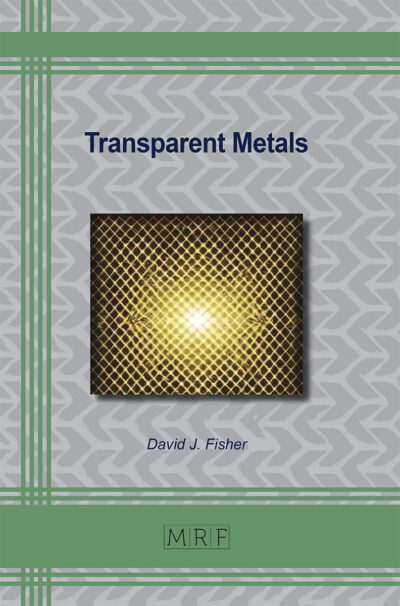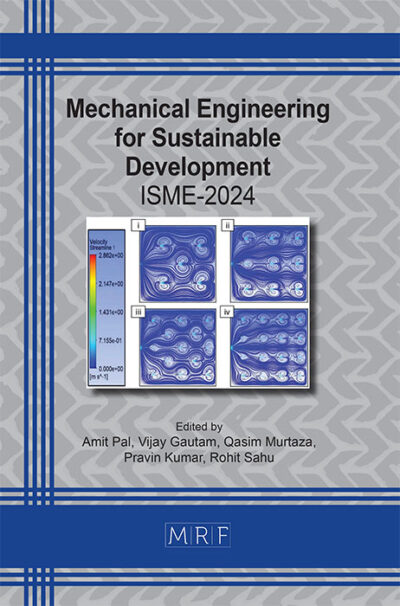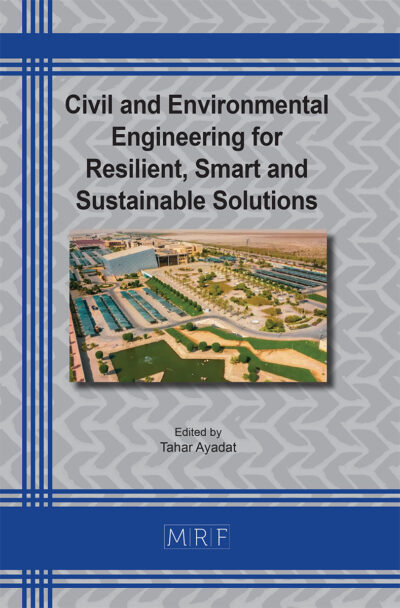Machine learning approach for predicting the compressive and flexural strengths of fiber-reinforced concrete mixtures
Roz-Ud-Din NASSAR, Khaled ABDALGADER
Abstract. This study employed the Extreme Gradient Boosting (XGBoost) Machine Learning (ML) model to predict the compressive and flexural strengths of concrete mixtures reinforced with 0.5, 1.0, and 1.5% of polyvinyl alcohol (PVA) fibers volume fractions at 28 days of concrete age. A significant increase in the compressive and flexural strengths of the resulting concrete mixtures was recorded as a result of the incorporation of PVA fibers, particularly at the higher fiber volume fraction level when compared with that of control mixture produced without the addition of PVA fibers. The ML model-predicted strengths data was found to be in close conformity with the experimentally tested one, pointing at the high accuracy of XGBoost model. Statistical analysis of the output variable data yielded lower error and higher R2 values (0.931 for compressive and 0.922 for flexural strengths) which confirm the suitability of the XGBoost model to predict the two types of strength characteristics of the PVC fiber reinforced concrete mixtures with high accuracy. The use of ML-model to predict the strength characteristics of PVA fiber-reinforced concrete mixtures is viewed to be a time-efficient method having high level of accuracy.
Keywords
Concrete, Machine Learning Model, XGBoost, Compressive Strength, Flexural Strength
Published online 2/25/2025, 10 pages
Copyright © 2025 by the author(s)
Published under license by Materials Research Forum LLC., Millersville PA, USA
Citation: Roz-Ud-Din NASSAR, Khaled ABDALGADER, Machine learning approach for predicting the compressive and flexural strengths of fiber-reinforced concrete mixtures, Materials Research Proceedings, Vol. 48, pp 407-416, 2025
DOI: https://doi.org/10.21741/9781644903414-45
The article was published as article 45 of the book Civil and Environmental Engineering for Resilient, Smart and Sustainable Solutions
![]() Content from this work may be used under the terms of the Creative Commons Attribution 3.0 license. Any further distribution of this work must maintain attribution to the author(s) and the title of the work, journal citation and DOI.
Content from this work may be used under the terms of the Creative Commons Attribution 3.0 license. Any further distribution of this work must maintain attribution to the author(s) and the title of the work, journal citation and DOI.
References
[1] Carpinteri, A., et al., Mode I fracture toughness of fibre reinforced concrete. Theoretical and Applied Fracture Mechanics, 2017. 91: p. 66-75 https://doi.org/10.1016/j.tafmec.2017.03.015
[2] Pakravan, H.R. and T. Ozbakkaloglu, Synthetic fibers for cementitious composites: A critical and in-depth review of recent advances. Construction and Building Materials, 2019. 207: p. 491-518 https://doi.org/10.1016/j.conbuildmat.2019.02.078
[3] Zhang, N., et al., Assessment of fiber factor for the fracture toughness of polyethylene fiber reinforced geopolymer. Construction and Building Materials, 2022. 319: p. 126130 https://doi.org/10.1016/j.conbuildmat.2021.126130
[4] Zhao, S., R. Liu, and J. Liu, Experimental study of the durability of high-performance cementitious composites with amorphous metallic fibers. Construction and Building Materials, 2023. 367: p. 130295 https://doi.org/10.1016/j.conbuildmat.2023.130295
[5] Zheng, Y., et al., A review of the mechanical properties and durability of basalt fiber-reinforced concrete. Construction and Building Materials, 2022. 359: p. 129360 https://doi.org/10.1016/j.conbuildmat.2022.129360
[6] Özkan, Ş. and F. Demir, The hybrid effects of PVA fiber and basalt fiber on mechanical performance of cost effective hybrid cementitious composites. Construction and Building Materials, 2020. 263: p. 120564 https://doi.org/10.1016/j.conbuildmat.2020.120564
[7] Zhuang, J., et al., Mechanical performance of basalt and PVA fiber reinforced hybrid-fiber engineered cementitious composite with superimposed basalt fiber content. Construction and Building Materials, 2022. 353: p. 129183 https://doi.org/10.1016/j.conbuildmat.2022.129183
[8] Ghasemzadeh Mousavinejad, S.H. and M. Parsa Alemi, Micro-structural and mechanical properties of PVA fiber reinforced engineered cementitious composite incorporating natural and artificial pozzolanic materials under different temperatures. Construction and Building Materials, 2022. 346: p. 128180 https://doi.org/10.1016/j.conbuildmat.2022.128180
[9] Ravichandran, D., et al., Influence of fibers on fresh and hardened properties of Ultra High Performance Concrete (UHPC)—A review. Journal of Building Engineering, 2022. 57: p. 104922 https://doi.org/10.1016/j.jobe.2022.104922
[10] Said, M., et al., Experimental analysis of torsional behavior of hybrid fiber reinforced concrete beams. Journal of Building Engineering, 2023. 71: p. 106574 https://doi.org/10.1016/j.jobe.2023.106574
[11] Xu, H., et al., Experimental study on durability of fiber reinforced concrete: Effect of cellulose fiber, polyvinyl alcohol fiber and polyolefin fiber. Construction and Building Materials, 2021. 306: p. 124867 https://doi.org/10.1016/j.conbuildmat.2021.124867
[12] Xu, H., et al., Experimental study on mechanical properties of fiber reinforced concrete: Effect of cellulose fiber, polyvinyl alcohol fiber and polyolefin fiber. Construction and Building Materials, 2020. 261: p. 120610 https://doi.org/10.1016/j.conbuildmat.2020.120610
[13] Basaran, B., et al., Estimation of the FRP-concrete bond strength with code formulations and machine learning algorithms. Composite Structures, 2021. 268: p. 113972 https://doi.org/10.1016/j.compstruct.2021.113972
[14] Nguyen, N.-H., et al., Simultaneous prediction the strain and energy absorption capacity of ultra-high performance fiber reinforced concretes by using multi-output regression model. Construction and Building Materials, 2023. 384: p. 131418 https://doi.org/10.1016/j.conbuildmat.2023.131418
[15] Mohtasham Moein, M., et al., Predictive models for concrete properties using machine learning and deep learning approaches: A review. Journal of Building Engineering, 2023. 63: p. 105444 https://doi.org/10.1016/j.jobe.2022.105444
[16] Hosseinzadeh, M., M. Dehestani, and A. Hosseinzadeh, Prediction of mechanical properties of recycled aggregate fly ash concrete employing machine learning algorithms. Journal of Building Engineering, 2023. 76: p. 107006 https://doi.org/10.1016/j.jobe.2023.107006
[17] Uddin, M.N., et al., Interpretable machine learning for predicting the strength of 3D printed fiber-reinforced concrete (3DP-FRC). Journal of Building Engineering, 2023. 72: p. 106648 https://doi.org/10.1016/j.jobe.2023.106648
[18] Shanmugasundaram, N., et al., Prediction on compressive strength of Engineered Cementitious composites using Machine learning approach. Construction and Building Materials, 2022. 342: p. 127933 https://doi.org/10.1016/j.conbuildmat.2022.127933
[19] Zhang, X., et al., Predicting the 28-day compressive strength by mix proportions: Insights from a large number of observations of industrially produced concrete. Construction and Building Materials, 2023. 400: p. 132754 https://doi.org/10.1016/j.conbuildmat.2023.132754
[20] Mohammed, N., et al., Machine learning and RSM-CCD analysis of green concrete made from waste water plastic bottle caps: Towards performance and optimization. Mechanics of Advanced Materials and Structures: p. 1-9 10.1080/15376494.2023.2238220:
[21] (ACI), A.C.I., Selecting Proportions for Normal-Density and High Density-Concrete – Guide. 2022, ACI: Michigan, USA.












